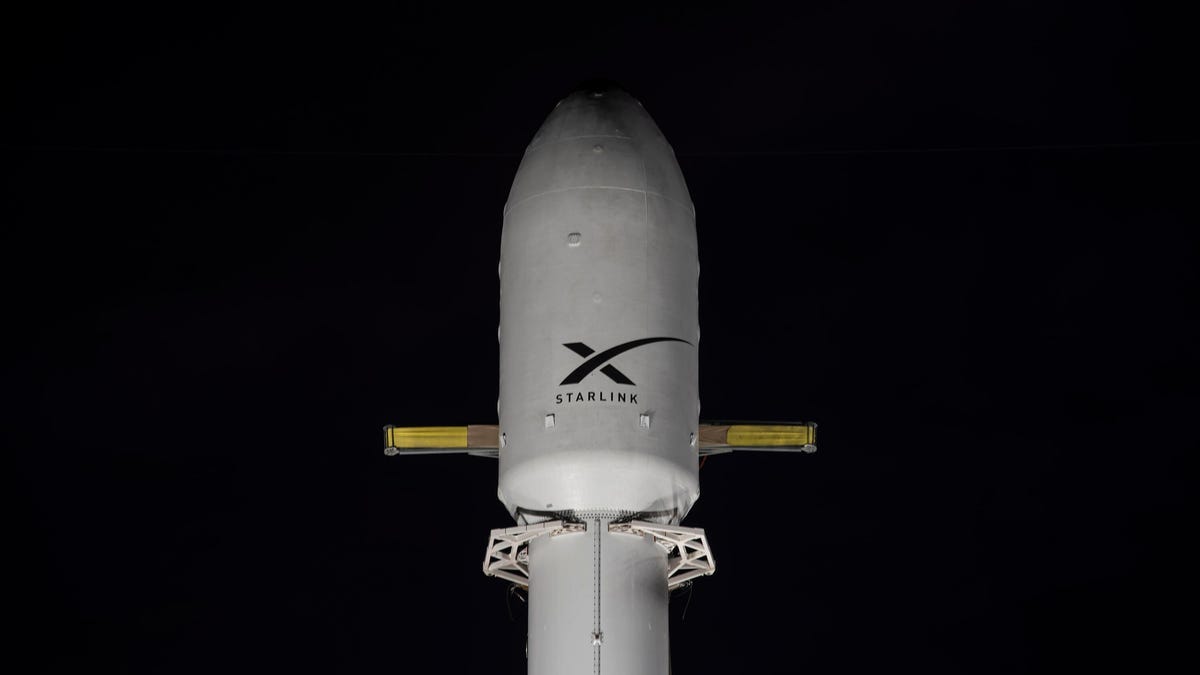Elon Musk's New Second-Gen Starlink Satellites Are Too Big for Current Rockets
The hefty Gen2 satellites will need the Starship heavy-lift rocket to get off the ground.

The fairing shield for 60 Starlink satellites awaits launch.
Starlink, the satellite internet division of Elon Musk's rocket company SpaceX, has developed a second-generation of satellites for low-Earth orbit. But they're too big to launch for now.
The Gen2 satellite is considerably larger than the more than 2,500 Starlink satellites now orbiting 340 miles above the Earth's surface. Gen2 satellites are 22 feet long and weigh 2,755 pounds, the SpaceX CEO said late last week on the YouTube show Everyday Astronaut. By contrast, the first-generation satellites weigh 573 pounds, or about one-fifth as much as Gen2.
"A lot of people talk a lot about how many launches per year there are to orbit, but this is not really what matters. I think what really matters is what's the total useful payload to orbit per year," Musk said. "'Cause otherwise you could say if this were ocean ships, you'd be like comparing a dinghy to a supertanker."
To get the much heavier Gen2 satellites into orbit, SpaceX will have to get its Starship heavy-lift rocket ready. Starship is the most powerful rocket ever built. It's made up of two stages: a first-stage booster called Super Heavy and an upper-stage called Starship. The US Federal Aviation Administration is conducting an environmental review of the reusable Starship rocket and on Tuesday extended its self-imposed deadline an additional two weeks, suggesting the final report is coming in mid-June.
SpaceX's progress on Gen2 shows how much further along Starlink is when compared with its competitors. Amazon's Project Kuiper isn't off the ground. OneWeb, a satellite internet constellation half-owned by the UK government, has 428 satellites in orbit at a higher 750-mile altitude. Canada's Telesat has 188 LEO satellites in space but is facing production delays.
Starlink has already brought high-speed internet for many rural communities out of reach of broadband. Starlink, with help from the US government, has been able to provide internet access to 150,000 Ukrainians in the midst of a war.
Demand is growing in different parts of the world for Starlink service. In the fourth quarter of last year, Starlink provided 100 Mbps speeds to 15 additional countries, according to speed test site Ookla. Counties such as Pakistan that haven't approved Starlink are seeing calls on Twitter for the service. #StarlinkinPakistan was trending on Wednesday.
Gen2 satellites are "almost an order of magnitude" greater than first-generation units, Musk said. Newer Gen2 satellites won't replace the current fleet in orbit but "complement the first-generation constellation" currently deployed, according to a SpaceX FCC filing.
Some Chinese researchers are worried by Starlink's rapid progress. Musk's satellite constellation is enough of a national security threat that recommendations have been made to either disable or destroy SpaceX's satellites. Researchers in China say US military drones and stealth fighter jets could see data transmission speeds increase by more than 100 times with Starlink.
NASA has voiced concern about Starlink's proposed 42,000 satellite-strong constellation, saying it may lead to a "significant increase in the frequency of conjunction events and possible impacts to NASA's science and human spaceflight missions." The space agency isn't suggesting that SpaceX stop its work but that it conduct testing to prevent collisions. Astronomers fear that satellite megaconstellations will obscure the night sky when they attempt to capture long-exposure imagery. A string of Starlink satellites passing above can leave bright streaks while capturing telescopic imagery, hindering the ability to study space.
Starlink's satellite internet service continues to grow and now reaches 32 countries and the Earth's poles.
Correction, June 1: Starlink is a division of SpaceX.

